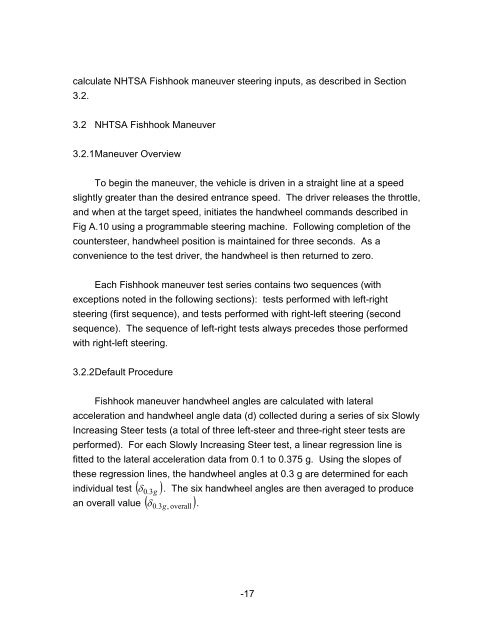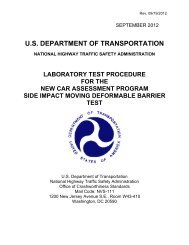Fishhook Maneuver Test Procedure - SaferCar.gov
Fishhook Maneuver Test Procedure - SaferCar.gov
Fishhook Maneuver Test Procedure - SaferCar.gov
You also want an ePaper? Increase the reach of your titles
YUMPU automatically turns print PDFs into web optimized ePapers that Google loves.
calculate NHTSA <strong>Fishhook</strong> maneuver steering inputs, as described in Section<br />
3.2.<br />
3.2 NHTSA <strong>Fishhook</strong> <strong>Maneuver</strong><br />
3.2.1 <strong>Maneuver</strong> Overview<br />
To begin the maneuver, the vehicle is driven in a straight line at a speed<br />
slightly greater than the desired entrance speed. The driver releases the throttle,<br />
and when at the target speed, initiates the handwheel commands described in<br />
Fig A.10 using a programmable steering machine. Following completion of the<br />
countersteer, handwheel position is maintained for three seconds. As a<br />
convenience to the test driver, the handwheel is then returned to zero.<br />
Each <strong>Fishhook</strong> maneuver test series contains two sequences (with<br />
exceptions noted in the following sections): tests performed with left-right<br />
steering (first sequence), and tests performed with right-left steering (second<br />
sequence). The sequence of left-right tests always precedes those performed<br />
with right-left steering.<br />
3.2.2 Default <strong>Procedure</strong><br />
<strong>Fishhook</strong> maneuver handwheel angles are calculated with lateral<br />
acceleration and handwheel angle data (d) collected during a series of six Slowly<br />
Increasing Steer tests (a total of three left-steer and three-right steer tests are<br />
performed). For each Slowly Increasing Steer test, a linear regression line is<br />
fitted to the lateral acceleration data from 0.1 to 0.375 g. Using the slopes of<br />
these regression lines, the handwheel angles at 0.3 g are determined for each<br />
individual test ( δ 0.3g ). The six handwheel angles are then averaged to produce<br />
an overall value ( δ ).<br />
0.<br />
3g,<br />
overall<br />
-17











